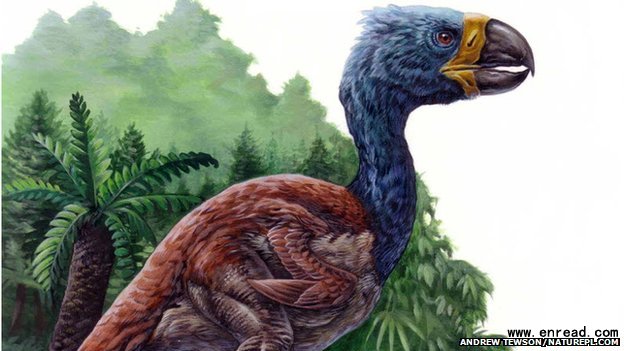巨型不飞鸟是“温和的食草动物”
时间:2012-11-23 08:07:33
(单词翻译:单击)
Footprints believed to have been made by the giant bird Diatryma indicate that it was a "gentle herbivore" and not a fierce carnivore, scientists say.
科学家称,巨型不飞鸟留下的脚印显示这种鸟是“温和的食草动物”,并非凶残的食肉动物。

The giant flightless Diatryma: unequipped to be a carnivore?
Previous investigations2 have suggested the giant bird was a carnivorous predator3 or scavenger4(食腐动物).
But the absence of raptor-like claws in the footprints supports the theory that Diatryma was not a meat-eater.
Measuring 7ft (2.13m) tall and with a huge head and beak5, the giant flightless bird Diatryma (believed by some experts to belong to the genus Gastornis) is commonly portrayed6 as a fierce predator in both scientific works and popular media.
The animal is frequently thought as "the bird that replaced dinosaurs7 as the top predator", said geologist8 and team member George Mustoe, from Western Washington University in Bellingham, US.
"Let's be honest: scary, fierce meat-eaters attract a lot more attention than gentle herbivores."
The study, published in the journal Paleontology, analysed a set of footprints made 55.8 to 48.6 million years ago in the Lower Eocene. Preserved in sandstone, the prints formed part of the Chuckanut Formation in northwest Washington, US.
The team concluded that the multiple, well-preserved tracks were most likely to have been made by Diatryma.
That would make them the only known footprints left behind by this giant bird, and they provide new evidence about what it ate.
"[The tracks] clearly show that the animals did not have long talons9, but rather short toenails(脚趾甲)," said David Tucker, from Western Washington University, who also worked on the study.
"This argues against an animal that catches prey10 and uses claws to hold it down. Carnivorous birds all have sharp, long talons."
点击 收听单词发音
收听单词发音
 收听单词发音
收听单词发音
1
landslide

|
|
| n.(竞选中)压倒多数的选票;一面倒的胜利 | |
参考例句: |
|
|
|
2
investigations

|
|
| (正式的)调查( investigation的名词复数 ); 侦查; 科学研究; 学术研究 | |
参考例句: |
|
|
|
3
predator

|
|
| n.捕食其它动物的动物;捕食者 | |
参考例句: |
|
|
|
4
scavenger

|
|
| n.以腐尸为食的动物,清扫工 | |
参考例句: |
|
|
|
5
beak

|
|
| n.鸟嘴,茶壶嘴,钩形鼻 | |
参考例句: |
|
|
|
6
portrayed

|
|
| v.画像( portray的过去式和过去分词 );描述;描绘;描画 | |
参考例句: |
|
|
|
7
dinosaurs

|
|
| n.恐龙( dinosaur的名词复数 );守旧落伍的人,过时落后的东西 | |
参考例句: |
|
|
|
8
geologist

|
|
| n.地质学家 | |
参考例句: |
|
|
|
9
talons

|
|
| n.(尤指猛禽的)爪( talon的名词复数 );(如爪般的)手指;爪状物;锁簧尖状突出部 | |
参考例句: |
|
|
|
10
prey

|
|
| n.被掠食者,牺牲者,掠食;v.捕食,掠夺,折磨 | |
参考例句: |
|
|
|
- 上一篇:墨西哥总统提议精简国名
- 下一篇:空气质量影响大脑认知
©2005-2010英文阅读网




